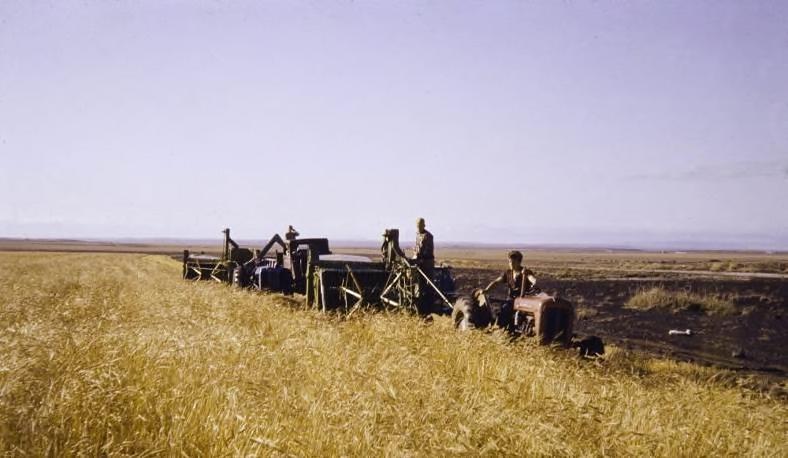
4 minute read
The small grain boom of the 1960s
lived (Figure 3). Poorer growing conditions in the 1960s were not only due to the decreasing summer temperatures but also to late springs and the early autumn frosts and storms.
Figure 3. Mean summer temperature (May-September) in Reykjavik 1924-2013 (red line) and means for the warmest 14 years 1928-41 (10.02°C), coldest 14 years 1979-86 (8.42°C) and the last 14 years 2000-2013 (9.79°C) (provided by Jónatan Hermannsson, based on data from the Icelandic Meteorological Office). As will be discussed later the successful grain cultivation in the years after 1990 clearly coincided with higher summer temperatures, although the highly significant, if not outstanding advances in barley breeding in Iceland in the 1990s are as important if not the crucial factor for this remarkable success.
The small grain boom of the 1960s
The summer of 1960 had many warm and sunny days. The author, having returned that spring from many years of studies abroad, was quite impressed with the rapid maturity of grain and grass seeds allowing for extensive collections of seeds of different types of pasture, hay and crop plants. This included imported brome grass (Bromus inermis) from North America, which did not bear viable seeds before 1960 or for many years after. The Icelandic Government, the Agricultural Society of Iceland, some private commercial firms and a number of farmers were stimulated by these favourable conditions and the recent success of some farmers to start large-scale grain production with the perhaps understandable hope and expectation that the year 1960 signalled the beginning of favourable growing conditions in Iceland for years to come. The Union of Icelandic Cooperatives (SIS) established large barley fields near Hvolsvöllur in south Iceland. Some private companies, e.g. the firm Hafrafell, also had large barley fields near the farm Gunnarsholt, the site of the Headquarters of the Soil Conservation Service. Gunnarsholt became the main site of the small grain research programme which started in 1961. In north east Iceland a large barley project was started in Suður-Thingeyjarsýsla, near the waterfall Goðafoss, by an Icelander, Bjarni Pétursson, who had just returned after several years of running a grain and beef farming operation in Colorado, U.S.A. He decided to use his experience and knowhow to set up Coloradostyle farming in this area. The farmers formed a cooperative and ploughed about 100 ha of land,

bought all the necessary equipment for small grain growing, including a combine and a drier to produce feed grain for their livestock. The author drew up the plans for them, ordered barley seed of the varieties thought to be best adapted to the area and the seeds were planted in the spring of 1962. The Minister of Agriculture at the time, Mr. Ingolfur Jónsson, stated in the Althing that grain growing in Iceland was still a risky business Figure 4. Farmers Sigfús Jónsson and Bjarni Pétursson, and Skapti and without extensive research Stefánsson advisor, in a barley field, Einarsstadir, S-Thing. 1962. work, primarily to develop better adapted grain varieties, it would not become a dependable farming enterprise in Iceland. This was most unusual for a politician to say in any country. In 1960 the Government had established the firm Feed and Seed at Gunnarsholt with the task of producing grass pellets, forage grass seeds and barley on eroded land reclaimed by the Soil Conservation Service. The firm purchased seeding equipment, combines and a grain drier. The Government also provided funds to the University of Iceland forFigure 5 1962. . Seeding a barley field in the sand “soil” at Gunnarsholt starting the research and breeding activities. The Minister appointed the present author to organize and lead this research which expanded rapidly in the early 1960s. In 1960 there were about 50 ha of barley in Iceland. In 1961, the acreage had grown tenfold to some 500 ha with yields of 1.6 – 2.0 t ha-1, giving about 800 to 2000 tons of dry grain (15% moisture). There were also some 200 ha of oats. It was reported on the radio that some farmers got up to 3 t ha-1 in 1961. Of this acreage about 300 ha were owned by state and private firms, all near Gunnarsholt in south Iceland. Although growing conditions for small grain growing were not considered optimal and the harvest season bad, the growers were in general not too unhappy with the outcome and the plans for 1962 were on a larger scale and many more farmers joined. The following parameters were recorded for the growing of barley at Gunnarsholt in 1961: the seed rate was 130-170 kg ha-1, the recommended fertilizer rates for sandy soils were 115 kg of N, 40 kg of P ( P2 O5, triple phosphate) and 50 kg of K (K2O potassium) ha-1. For loam soils the recommendations were: 43-56 kg N (higher N applications had been shown to delay ripening), 40 kg P and 50 kg K ha-1. The time of seeding and fertilizer application was in general between 2 and 20 May. The first trial was harvested on 7 September and harvest was completed on 7 October. The moisture content of the grain at harvest was 40-50%. It was then dried in oil driers down to 15% moisture for storage (personal records from








